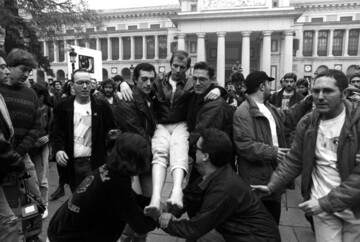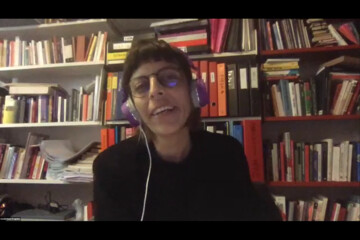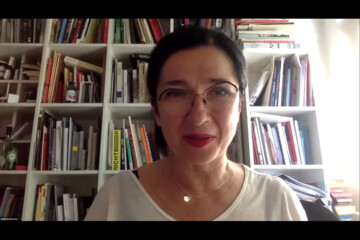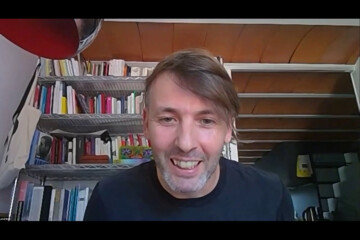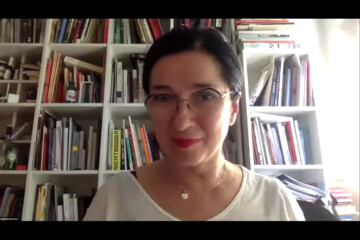Caring for objects
The concept of → cared (→ care) is not only part of our social protocols but also deeply rooted in our language and history. According to Péter P. Müller:
Different languages have preserved different memories in their vocabulary of various aspects of human experience. Ancient connections between words and experiences are often neglected, and we rarely think of tracing our current vocabulary back to its original roots. However, a thorough investigation can reveal essential links between words used frequently in everyday life.[1]
The word “curator” – one who has the care and superintendence of something, especially, one in charge of a museum, or other places of exhibiting[2] – was, apparently, first used in the modern sense in the 16th century, yet derived as it is from “care” its etymology is rooted even more deeply in the past, reaching back – by another millennium – to such Indo-European languages as Old High German, where “care” had connotations of “sorrow”, and “lament”.[3] From the historic perspective, the curator is thus someone who cares for what they have been entrusted with. For someone working in a museum, this means valuable objects and exhibition displays. As the media theoretician and philosopher Boris Groys, not uncritically, notes, art museums have traditionally relied on the universal notion of art history. Originally, the museum, in a logical consequence of being treated as a kind of time capsule, served to preserve and protect the objects therein from the incessant fluctuation and chaos of the surrounding material environment. After all, the history of museology and art collection emerges, among other things, from the concept of the Kunstkamera – museum as an encyclopaedic cabinet of curiosities and rarities, conveying the order of the world represented by means of artefacts that are viewed as manifold representations of knowledge and art. As Groys rightly notes:
Traditionally, the main occupation of art was to resist the flow of time. Public art museums and big private art collections were created to select certain objects – the artworks – take them out of private and public use, and therefore immunise them against the destructive force of time. Thus, our art museums became huge garbage cans of history in which things were kept and exhibited that had no use anymore in real life: sacral images of past religions or status objects of past lifestyles. [4]
In this context, the curator was given the role of the guardian, or – to draw on the Latin meaning of “curare” – caring about, caring for and watching over the relics of the past, also in the spiritual sense. Thus, the concept of preserving and renewal, inherent in the job of the curator, has gained the connotations of emotional care and the ethics of caring. And while the notions of “curating” and “care” go together like a horse and carriage, for a long time throughout the history of exhibitions such attentive concern had been → invested solely in objects rather than people. Only the paradigm shift in art, which took place at the beginning of the 1990s, and which the researchers of the subject referred to in different ways – a performative, narrative or choreographic turn (after Claire Bishop), all located in the field of visual arts, [5] relational art (after Nicolas Bourriaud),[6] or simply the theatralisation of the exhibition space (after Boris Groys) – redirected the attention of the art world from the object to the performer and the audiences, referring to care as an important factor accompanying visual art performances and collective artistic practices. To care for objects is quite different from caring about people or the community. As Groys writes:
Nowadays, one speaks time and again about the theatralisation of the museum. Indeed, in our time people come to exhibition openings in the same way as they went to opera and theatre premieres in the past. This theatralisation of the museum is often criticised because it might be seen as a sign of the museum’s involvement in the contemporary entertainment industry. However, there is a crucial difference between the installation space and the theatrical space. In the theatre, spectators remain in an outside position vis-à-vis the stage, but in the museum, they enter the stage, and find themselves inside the spectacle. Thus, the contemporary museum realises the modernist dream that the theatre itself was never able to fully realise – of a theatre in which there is no clear boundary between the stage and the space of the audience.[7]
In order for the performance that Groys writes about to fulfil its role of “creating experience”, the audience must feel safe and the performers must be given appropriate care by the institution and the curators. Unlike objects, bodies cannot perform non-stop. Bodies operate according to different protocols and have different requirements than museum objects, and they react to temperature and surroundings in a particular way. The protocols of care referred to above are modified depending on the circumstances, such as when the participants are children or non-human performers.[8]
Compared to the theatre, in the white cube there is an unconventional distance between the body and audience – bodies will be taken care of and reacted to differently than objects. A different understanding of care has migrated to the exhibition space from performative and choreographic practices, from the area of → feminist theory and from the field of experimental theatre, where the ethics of care occupies a special place, where collective work, intimacy and the notion of safe space create ethical guidelines for working with the performer. A new quality is being created in the white cube, where the relationship between the bodies and audience is no longer regulated by the architecture of the theatre calculated into the traditional division: stage and audience.
Caring for someone
The development of care practices in the visual arts space is closely linked to the development of the critical feminist theory and feminist ethics of care from which contemporary humanities draw, showing our emotions and sensitivity as a manifestation of strength and telling the truth, and not as signs of weakness. The ethics of care stimulates thinking about the healing and purifying powers of art itself, which is etymologically linked to the original meaning of the Latin word “cure”, meaning “care”. Thinking about care, however, we should not forget that the act of care is also a challenge in the context of interpersonal relationships aimed at various forms of hospitality.
This is what the feminist theorist Sara Ahmed writes in her book about happiness:
There is nothing more vulnerable than caring for someone; it means not only giving your energy to that which is not you but also caring for that which is beyond or outside your control. Caring is anxious – to be full of care, to be careful, is to take care of things by becoming anxious about their future, where the future is embodied in the fragility of an object whose persistence matters. Becoming caring is not about becoming good or nice: people who “being caring” as their ego ideal often act in quite uncaring ways in order to protect their good image of themselves. To care is not about letting an object go but holding on to an object by letting oneself go, giving oneself over to something that is not one’s own. [9]
It should be emphasised that the concept of care was the central idea for many artists from the past, especially in the context of early performance art practices developed by female artists as Marina Abramović, Yoko Ono, Carolee Schneemann, Joan Jonas and Laurie Anderson. The notion of care could concern objects and humans but also non-humans, such as we observe in the Carolee Schneemann’s films Fuses (1964–67) or images of her cat, Kitch (Kitch’s Last Meal, 1975).
The practice of care can be addressed to the closest family members, as in the case of Lea Lublin’s performance with her seven-month-old son – himself an “exhibit” in a show at the Museum of Modern Art in Paris (Musée d’Art moderne de la Ville de Paris; 1968). Lea Lublin in her performance visualised unpaid and invisible labour of caring:
She transforms a moment of her everyday life into artistic action. Mon fils (My Son) highlights a recurring subject in the artist’s work, transposing the lived experience of everyday life into artistic action and revealing it in an act of representation that questions us both about form and concept. This performance encapsulates her identity as artist, woman and → mother refusing to prioritise art over life. [...] The female body – first and foremost, repressed – runs through her practice, converging ultimately in Le corps amer (à-mère), The Bitter Body (The Mother’s Body).[10]
By taking her baby son to the museum during the regular exhibition hours, Lublin is overcoming the boundaries separating art and life. By looking after her son, changing diapers, breastfeeding and putting him to sleep in a bed she has temporarily installed in the museum space next to the artworks, she brings public attention to social and gender roles in her work, closely engaging with currents in critical theory, influenced by French feminism and philosophy – engaging in active social dialogue. The action in the museum performed by Lea Lublin, in a very precise way, contextualises the performance of care developed by female performance artists in the 1970s.
Caring society
Caring can arise out of engaging with specific communities, as we witness in the photographic works by Nan Goldin or the recent project-cum-supergroup by Ingo Niermann entitled Army of Love, formed around a specific community and an idea of different manifestations of love “in the face of patriarchy, racism and neoliberal corporo-fascism”.
The concept of care may also occur as a consequence of the experience of an illness, as was the case with one of the key artists in the recent history of contemporary art in Spain, Pepe Espaliú, who died in November 1993 in Córdoba. Just three years earlier, he found out that he was HIV-positive.
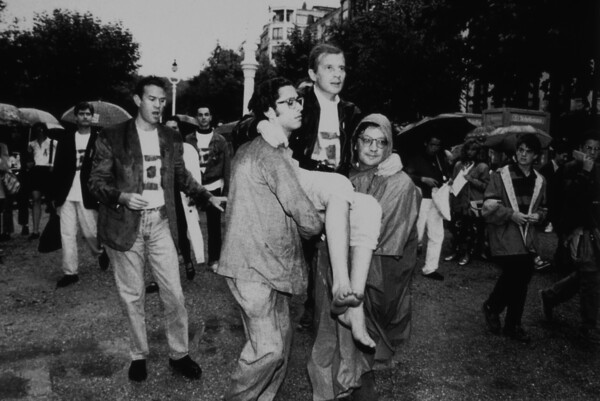
Pepe Espaliú, The Carrying Project, 1992, performance. Copyright © Arteleku / Ricardo Iriarte.
The Carrying Project, which he focused on in the last year of his life, evolved as a consequence of his illness and an attempt to regain control of his deteriorating body. The first work from the series was a performance in San Sebastian, and later on in Madrid, where the performance ended in the Reina Sofia Museum. The photos taken in 1992 during Pepe Espaliú’s performance The Carrying Society are memorable. The event in Madrid had huge repercussions in the media. In the video and photo documentation, we see the bare-footed artist being carried by friends and passers-by. They took him on an unusual tour of the popular inner-city districts of Spanish cities.
The act of carrying the artist’s body in this strange procession became a gesture of exposing his → vulnerability and corporal fragility. The action revealed his concern, fear and trauma of being terminally ill. The body, non-heteronormative identity, power, illness, and inevitable death were progressively woven together in his objects, performances and installations.
Later, → after contracting HIV, Pepe Espaliú simplified and reoriented his iconography towards his illness; this was when he created his famous crutches and carrying chairs, and ultimately took part in his famous public actions that are remembered as much for their social and political transcendence as their artistic aspect.[11]
The Carrying Project could be perceived metaphorically. It shows the bond between the individual body and the community. “Carrying” sounds like “caring” – helping each other and protecting each other. In the collective consciousness of the early 1990s, AIDS belonged to that group of illnesses which reflected moral shame. Susan Sontag, in her essay “AIDS and Its Metaphors”, argues that metaphorical thinking about disease leads to placing the burden of guilt on the patient. As she notes, the transmission of AIDS is described in terms of pollution, which reopens the concept of “disease as punishment”. As Susan Sontag observed:
Any important disease whose causality is murky, and for which treatment is ineffectual, tends to be awash in significance. First, the subjects of deepest dread (corruption, decay, pollution, anomy, weakness) are identified with the disease. The disease itself becomes a metaphor. [12]
The ritual of carrying the sick body during Pepe Espaliú’s performance has undoubtedly magical properties and releases the moment of purification. This is a symbolic action in which → solidarity and a caring society are born!
The institution of care
The contemporary notion of care is, however, deeply rooted in the phenomenon of relational aesthetics and the performative turn manifested at the beginning of the 2000s. The concept is connected to the changing idea of spectatorship, and it asks to be understood via performative and choreographic practices.
The performative notion of art raises the question of the body and the ongoing work carried out in the course of extended performative exhibitions and public programmes, reflecting on how art institutions take care of performing bodies and how they respond to the new challenges related to this. Does altering the economics of the artwork and exhibition space affect audiences and the working conditions of all those involved? Or are we dealing with a new kind of constantly evolving performative institution that never sleeps, in the grip of a compulsion to create “nonmaterial” experiences that are the key to success in a globalised job market? The analytic scope includes the, broadly conceived, “body of the performer”, considered not only individually but also as a collective subject or social phenomenon. And this body needs to be taken care of.[13]
Art institutions have the potential to create communities based on the notions of mutual care, togetherness, solidarity, belonging, a shared identity and especially a shared experience in the context of visual and performing arts. This specific institutional moment is always connected to specific communities, mutual care and also to a changing role of the spectators who more and more often become performers and active participants in the museum programmes.
In 2018, the summer in Warsaw was quite hot. A crowd of mostly young people gathered in park, next to the Ujazdowski Castle Centre for Contemporary Art. The space of Dragana Bar turned out to be too small to accommodate all the guests. Hundreds of people took places under the trees and on the grass. Dragana Bar was created in collaboration with the → queer feminist collective Kem (co-founded and run by choreographer Alex Baczyński-Jenkins, Krzysztof Babinski, Ola Knychalska and Ania Miczko among others), for which the concept of care is the central idea. The project was part of one-year residency testing the institution itself and investigating how an artistic collective could inhabit its infrastructure for queer and feminist purposes.
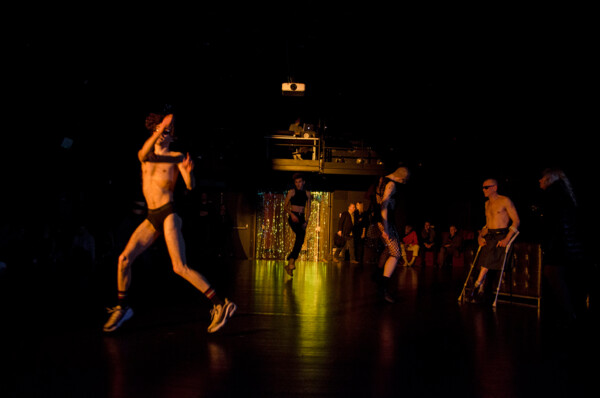
Alex Baczyński-Jenkins, Untitled, 2018, performance, Dragana Bar, Ujazdowski Castle Centre for Contemporary Art, Warsaw. Photo: Katarzyna Szugajew.
As part of the Dragana Bar project, the institution decided to build an alternative temporary entrance to the historical building through the window. The place hosted the performance programme and a series of small artistic interventions. The community around the institution was created by means of being and dancing together. This idea was strongly inspired by the “social choreography” developed in performative works by Alex Baczyński-Jenkins. Unfortunately, after a few months the project came to an abrupt end because of a radical change in Poland’s political climate and the institution itself. No more than a few moments from Dragana Bar have been captured in some amateur photos, but the memory of this joyful summer will stay forever. A few months later, Dragana Bar appeared as strong reference during the performance presented at Ujazdowski Castle by Alex Baczyński-Jenkins, entitled Untitled Dances and based on the theatrical practice of Akademia Ruchu.[14] Dragana Bar has become testimony to how much mutual care and self-care is needed to sustain a community and how fragile and defenceless a community can be. In the event, however, the notion of togetherness was documented and passed on as chorographical experience. It became part of a particular archive contained in bodies of spectators, performers and curators – who were witnesses to the singular, ephemeral “social choreography” created during this memorable summer in the park.
The movement in the pause
The idea of an institution of care based on community, assistance, solidarity and hospitality is also inseparable from anxiety and sacrifice. Concern contains ambiguity and so does hospitality, as pointed out by Jacques Derrida when he wrote about “conditional hospitality”.[15]
The events of recent months related to the COVID-19 pandemic have not only re-evaluated the global order, but have also given a different meaning to the concept of care itself. The epidemiological threat has drastically worsened the already precarious situation of many professional groups, especially those employed in creative sectors. Numerous artists and art workers, including educators, guides, art gallery staff, and freelance curators, have been left without any means of subsistence or legal protection overnight. At the same time, the threat of COVID-19 is being used for political struggle against various ethnic groups, LGBTQA+ people, and even women’s rights. Will the new situation that art institutions find themselves in lead to a re-evaluation of the concept of care? As André Lepecki notes, the moment of pause and temporary suspension is no more than an illusion:
In the lockdown, in the pause, in the supervision, as our movements, gestures, and actions endure radical transformations, compressed as they are to the limits defined by our walls, we soon realise that nothing has really stopped – not inside our homes and not in the external world, where the homeless survive at the mercy of more or less planned neglect, more or less police brutality, more or less charity […] Locked in place, we realised that management, surveillance, and control of movement has become a central fact in the pandemic. The metaphors of “pause”, “home-sheltering”, “suspension of activity” only mask the hyper-activity of capital and police (capital as police) throughout the confinement and as the confinement. [16]
It is still difficult to assess the actual consequences of the continuing pandemic. At the moment the sight of the Spanish artist Pepe Espaliú carried through the city in a throng of people belongs to a different order of reality – one that only a few months ago we would have found hard to believe could be suspended. Today, museums and art galleries must rethink again, and critically, the concept of the institution of care as well as the relationships that they have been engaged in building with the audiences and the artists.

